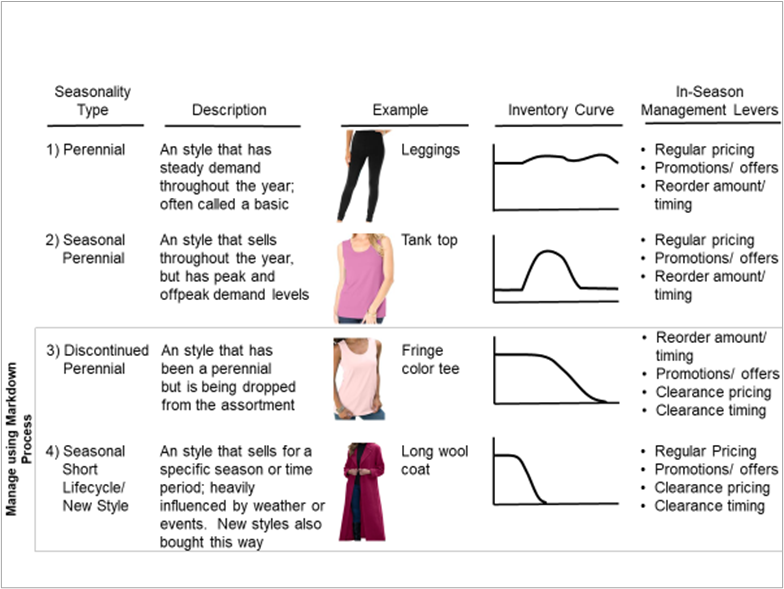 Josh Pollack
Josh Pollack
VP, Implementation and Business Development
Many retailers just are not able to take advantage of today’s advanced pricing analytics tools for managing markdowns. Whatever their reasons—some will lack the resources to invest or the necessary system or data infrastructure to support it, others will be tied up with other IT priorities—for these retailers, strict adherence to a strong process-based approach will yield many of the same benefits as a full-blown markdown optimization management system.
The goal is to drive better merchandise margins and inventory performance through improved pricing at the end of a product’s lifecycle or as the end of peak season approaches.
The markdown process outlined below is meant for retailers with significant amounts of short-lifecycle or discontinued products. You should not use this markdown process for recurring basic and core items; rather, you should manage inventory for these items by manipulating future orders and changing planned promotions.
This is Part 1 of a three-part series. Parts 2 and 3 will describe the process for setting liquidation percentages and markdown cadences.
Markdown Optimization Process: Overview
These are the two most common mistakes that retailers make when managing clearance:
- Waiting too long to start the markdown process
- Taking initial discounts that are too small
Academic research and real-world experience show that margin dollars are maximized when retailers start marking down before demand dwindles. Yet many merchants defer markdowns to preserve margin rates, keeping items at regular retail price until well past peak demand—then slash prices to reduce inventory prior to season end, inventory liquidation, or whatever their mechanisms for the final disposition of leftover goods.
Retailers in this situation miss out on substantial margin dollars.

The markdown optimization process should be applied to Seasonal/Short Lifecycle (SSL), New, and Discontinued Perennial Seasonality Types.
Markdown Optimization Process: Seasonality Types
To clarify the products to which this markdown process applies, consider the “Seasonality Types” described below, which you should be able to identify for every item you sell. In fact, the Seasonality Type may even be a product attribute in the Item Master or in tools used for the assortment planning process.
Note that Seasonality Types may apply at different product levels such as style, flavor, or color, as items may have both basic and seasonal or novelty varieties that should be treated differently during the markdown process.
Markdown Optimization Seasonality Type: Perennial
Normally, Perennial items are not managed using this markdown optimization process.
A Perennial is an item with steady demand throughout the year. It is a recurring basic style, not subject to significant seasonality, with a fairly flat inventory level. Think of black leggings.
In-season Perennial inventory management (related to inventory or sales levels) should concentrate on managing promotional offers, manipulating reorder amounts and timing, and potentially regular price changes.
Markdown Optimization Seasonality Type: Seasonal Perennial
As with Perennial items, Seasonal Perennials should not be managed using this markdown optimization process.
A Seasonal Perennial item sells all year but has a distinct seasonal peak. Think of a basic, colored tank top. This style is offered in the assortment and sells all year long as a layering piece but peaks during the hotter months. Inventory levels for Seasonal Perennials have a nonpeak steady state and then demand increases dramatically during the peak period.
Seasonal Perennial inventory management should concentrate on effective quantification of buys, manipulation of reorder amounts and timing, and potentially regular price changes.
Markdown Optimization Seasonality Type: Discontinued Perennial
Discontinued Perennials inventory should be managed using this markdown optimization process, as well as through changes to promotional plans and through manipulation or cancellation of any reorder amounts.
A Discontinued Perennial is a Perennial or Seasonal Perennial item that has been dropped from the assortment and needs to be liquidated. Almost any Perennial or Seasonal Perennial item could become a Discontinued Perennial as it approaches the end of its customer appeal. Think of a fashion color of a basic tee shirt. Inventory levels for Discontinued Perennials should decrease until they approach zero prior to liquidation.
Markdown Optimization Seasonality Type: Seasonal/Short Lifecycle (SSL)
SSL inventory levels should be managed using this markdown optimization process, as well as through changes to promotional plans, and through manipulation or cancellation of any reorder amounts.
SSL items are items that sell only for a specific season or time. Think of a heavy winter coat or pair of novelty shorts. SSL sales are heavily influenced by weather patterns or events such as Christmas. SSL inventory levels should decrease until they approach zero prior to liquidation.
Markdown Optimization Seasonality Type: New Items
Inventory levels for New items should be managed using this markdown optimization process, as well as through changes to promotional plans, and through manipulation or cancellation of any reorder amounts.
New items, whether intended for short lifecycles or expected to mature into Perennial items, should be treated in the same way as SSL items—as if they were going to be terminated at the end of the season unless their in-season performance warrants a transition to a different Seasonality Type.
Markdown Optimization Process: To Be Continued!
This is Part 1 in a three-part series of blogs outlining a strong markdown optimization process for use by retailers who, for whatever reason, are not taking advantage of markdown optimization software.
Part 2 covers how to calculate liquidation percentages.
Part 3 will cover how to determine the markdown cadence.
For simplicity’s sake, I’ll refer to all Seasonality Types subject to this markdown optimization process as “SSL.”
Stay tuned!
Take the Next Step
I’d be selling you short if I didn’t encourage you to explore our industry-leading pricing optimization software, Impact Analytics PriceSmart™.





